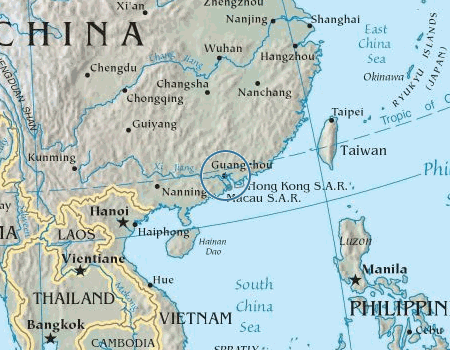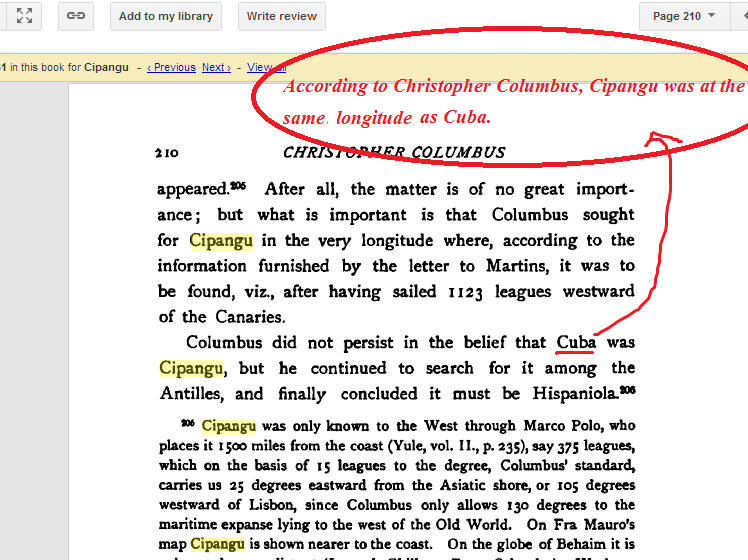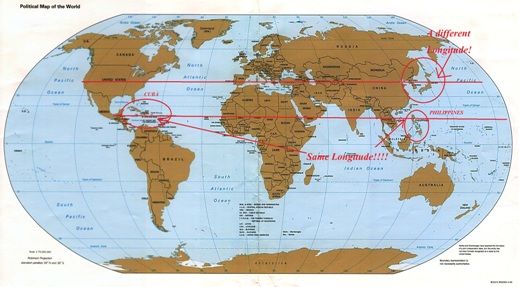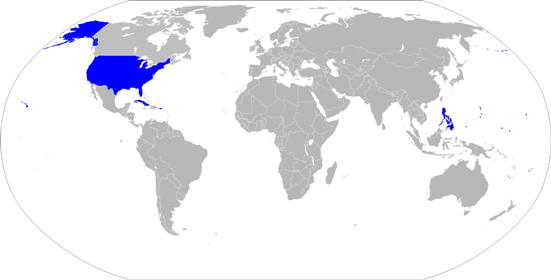Disclaimer: I already made a post about this in the Philippines section but I'm making another post here to find out what Japanese people think. ^_^
There is currently a debate among historians over whether Cipangu was the Philippines or Japan...
First of all, let me guys introduce you to the subject. The Japanese claimed that Japan was Cipangu when they adopted the mythos in the 17th century. This is echoed in contemporary articles which echo the Japan is Cipangu claim...
THE CLAIM
Thirteenth-century Japan has this in common with early 19th-century Japan: a land culture paying scant heed to the sea until the sea, as though in outrage, rises up and compels attention.
The dominant features of 13th-century Japan are Zen Buddhism and the newly empowered samurai; of early 19th-century Japan, Confucianism and sakoku — the country closed to the outside world. In the earlier period, only fishermen and pirates are afloat; in the later, them and the occasional castaway.
A 13th-century samurai, rigorously trained to an ascetic view of life, would have been astonished to read the dazzled fantasies his contemporary, the great Venetian traveler Marco Polo, was spinning about Japan.
As a teenager, Polo (1254-1324) had journeyed to China with his father and uncle, merchant-traders in gems and silks and other Oriental exotica. For 17 years, Marco stayed on at the Peking court of China’s Mongol ruler Kublai Khan, serving as envoy, confidant and adviser. His “Travels,” written long after his return, recounted his adventures in a part of the world scarcely known to most Europeans.
He never visited “the noble island of Cipangu,” but the rumors he recorded about it changed history, on land and at sea.
Polo’s Japan is a mythical El Dorado, a land overflowing with gold and precious stones. “I can report to you in sober truth a veritable marvel concerning a certain palace of the ruler of the island. You may take it for a fact that he has a very large palace entirely roofed with fine gold . . . They have pearls in abundance . . . and many other precious stones in abundance. It is a very rich island, so that no one can count its riches.”
No one knows who Polo would have heard this from — perhaps from whoever brought the news to Kublai, if Polo himself wasn’t Kublai’s source. In any case, “When tidings of (Cipangu’s) riches were brought to the Great Khan . . . he declared his resolve to conquer the island. Thereupon he sent . . . a great fleet of ships . . . “
The rest of that story is well known; this was the very fleet that in 1274 was repulsed and destroyed, the Japanese believed, by a kamikaze, a divine wind. (A second invasion attempt seven years later met a similar fate.)
It was via Polo that the Cipangu bug bit another great traveler — the Genoese mariner Christopher Columbus (1451-1506). “I have read a good deal in Marco Polo,” he wrote in 1484 to King John of Portugal, seeking sponsorship, “and reached the conception that over this Western Ocean Sea (the Atlantic) one could sail to this Isle of Cipangu and other unknown lands.”
Polo had grossly exaggerated the eastward extent of Asia, with Cipangu, he said, some 2,000 km (instead of 800) off the China coast. Columbus seized on this and other indications to justify his contemplated westward voyage to the fabled Indies. Following Polo, he concluded that “there are no great spaces of sea to be passed.”
King John was not impressed. He dismissed Columbus as “a big talker . . . full of fancy and imagination with his Isle of Cipangu.”
This reminds us that during his lifetime, Columbus was regarded as more crank than hero. It took him years to find a sponsor for his “Enterprise of the Indies.” Finally, in 1492, Queen Isabella of Spain agreed to stake him. Thereafter he made four voyages across the Atlantic. He died in 1506, firm in his belief that his legacy was not an unwanted “new world” but a westward sea route to East Asia.
Japan’s Columbus — its discoverer of America — began life as an illiterate Shikoku fisherman named Manjiro (1827-98). He was 14 when a typhoon wrecked his boat and washed him and four companions onto a desert island somewhere in the Pacific. This was in 1841. Sakoku was still in force. Leaving Japan — or, having left, returning — was a capital offense. Manjiro did not return for 10 years.
He spent those years in the United States, having been rescued by a Massachusetts whaling captain who adopted him, named him John, and gave him an American education. Returning to Japan in 1851 at the risk of his life, he was taken to Nagasaki and thrown in prison. For nine months he regaled his interrogators with fabulous tales of outlandish wonders — tales as fantastic as Marco Polo’s of Cipangu — with the difference that the steamships, telegraphs and railways of America actually existed.
John Manjiro was eventually released and accorded samurai status. Summoned to Edo (present-day Tokyo) in 1854, he helped negotiate with the Americans who came in their “Black Ships” to demand an end to sakoku. The ensuing Treaty of Amity was ratified in 1860, Manjiro accompanying the Japanese delegation to Washington and New York as its chief interpreter.
“Over the Western sea hither from Niphon come,/ Courteous, the swart-cheek’d two-sworded envoys,” wrote the American poet Walt Whitman, celebrating the occasion.
He saw vast implications.
“Bend your proud neck,” he urged his countrymen, “to the long-off mother now sending messages over the archipelagoes to you.”
http://www.japantimes.co.jp/life/200...dlocked-isles/
ADDENDUM: Cipangu was purportedly famous for these things: gold, incense, spices and pearls.
THE REALITY
However, Japan does not manufacture pearls it wasn't even famous for Pearl production during that era and Japan doesn't even have gold deposits in its mines. The Japanese themselves admit that they are a metals poor country that's why metal smithing is sophisticated in Japan because they learned how to recycle metals alot. Likewise, spices which are often tropical in nature cannot grow well in winter visited Japan.
However, one country does fit the description, a description that obviously doesn't fit Japan's.
But fits the Philippines...
A kingdom in the Philippines: The Rajahnate of Butuan was famous for manufacturing high quality gold.
The Indianized Kingdom of Butuan or the Rajahnate of Butuan (Cebuano: Gingharian sa Butuan; Tagalog: Kaharian ng Butuan; 蒲端國 in Chinese records) was an ancient Indianized kingdom in pre-colonial southern Philippines centered on the present Mindanao island city of Butuan. It was known for its mining of gold, its gold products and its extensive trade network across the Nusantara area. The kingdom had trading relationships with the ancient civilizations of Japan, China, India, Indonesia, Persia, Cambodia and areas now comprised in Thailand.
http://en.wikipedia.org/wiki/Kingdom_of_Butuan
~An area which mines and produces fine gold: it's the Philippines, checked.
Another kingdom in the Philippines: The Sultanate of Sulu was also famous for manufacturing fine pearls.
The Sultanate of Sulu Dar al-Islam[note 1] (Jawi: سلطنة سولو دار الإسلام) (Arabic: سلطنة سولو) was an Islamic Tausūg[note 2] state that ruled over many of the islands of the Sulu Sea, parts of Mindanao and certain portions of present-day Sabah (then North Borneo).[3]
The sultanate was founded in 17 November 1405.[4][note 3] by a Johore-born Arab explorer and religious scholar Sayyid Abu Bakr Abirin[note 4] after he settled in Banua Buansa Ummah (ummah is an Arabic term for "community"), Sulu. After the marriage of Abu Bakr and local dayang-dayang (princess) Paramisuli, he founded the sultanate and assumed the title Paduka Mahasari Maulana al Sultan Sharif ul-Hāshim.
Fishing is the most important industry since the Sulu Sea is one of the richest fishing grounds in the country. The province also have an extensive pearl industry. Pearls are extensively gathered and a pearl farm is established at Marungas Island. The backs of sea turtles are made into beautiful trays and combs. During breaks from fishing, the people build boats and weave mats.
http://en.wikipedia.org/wiki/Sulu
~An area which grows rare pears: it's the Philippines, checked.
Another kingdom in the Philippines: The Huangdom of Luzon, were the commercial distributors of spice and incense grown in Timor and Mallaku across Maritime East and Southeast Asia.
The evidence suggests that the "Luzons," known to the Portuguese as Luções, were among the primary traders, if not the main ones, on three of the most important regional trade routes of the time. The Luzons of that period had very close relations with the kingdom of Brunei according to various European sources. Rui de Brito Patalim even states in 1514: "The people of that island [Brunei] call themselves Luções.[8]" For the next decade, Portuguese sources continued to use the term " Luções" to refer to the people of Brunei even though they clearly knew of the Luções on the island of Luzon (Lução).
Tome Pires, writing in the early 1500s, described Lução as ten days sailing from Brunei[9], and Pedro Fidalgo, who landed on the island after a storm drove his ship off course while sailing toward Brunei in 1545, described Luzon as lying between the latitudes nine and 22 degrees North[10].
Pires also mentions a community of people from Luzon in Malacca including influential maritime traders, and he mentions that the Luzons and the people of Brunei were almost "one people." The evidence seems to suggest that the merchants of Luzon were conducting a great deal of the trade across Southeast Asia and northward to China including possibly much of the sandalwood trade.
International relations including royal intermarriages may also have helped cement ties between Luzons and others in the Philippines with people throughout the Southeast Asia region. Pigafetta, for example, mentions that a prince of Luzon acted as admiral for the king of Brunei. Rajah Soliman of Manila's son married the daughter of the Sultan of Brunei, and many relatives of the Rajahs Lakandula, Soliman and Matanda fled to Brunei along with their entourages after the Spanish invasion of Luzon. Humabon, the King of Cebu during Magellan's visit, was fluent in either Malay, Cham or Thai, which he used to speak with a merchant from "Ciama[18]
~Junker, Laura L. Raiding, Trading, and Feasting: The Political Economy of Philippine Chiefdoms. Honolulu: University of Hawaiì Press, 1999. Internet resource, 109; Antony, Robert J. Elusive Pirates, Pervasive Smugglers: Violence and Clandestine Trade in the Greater China Seas. Hong Kong: Hong Kong University Press, 2010. Print, 76.
http://sambali.blogspot.com/
~An area which distributed the incense and spices grown in Indonesia across Asia: it's the Philippines, checked.
So; gold, spices, incense and pearls are not products associated with the then Hermit-Empire descended from gods, Japan, BUT clearly products associated with the humble mariner kingdoms found in the Philippines.
Furthermore, what gives further proof that the Philippines was Cipangu, not Japan is simply the geographic location.
Just examine this old 15th century map.

Cipangu is right across Vietnam (Champa) and due south from the port of Guangzhou.
Jeeze, where o where was the port of Guangzhou?

More importantly, where oh where was the kingdom of Ciampa?
So since, Cipangu's immediate western and northern neighbors were the Viceroyalty of Kawngtung with its capital at Guangzhou and the Indianized Kingdom of Chiampa with its capital at Indrapura...
So. how did Cipangu which is supposed to be neighbors with Guangzhou and Indrapura end up at Japan which is far away from Indrapura and Ghuanzhou?
The scientific evidence points to the kingdoms of the Philippines being the fabled Cipangu not the Japanese Empire.


 Originally Posted by MrC
Originally Posted by MrC 







